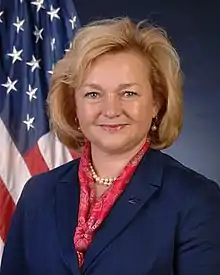Angela R. Hight Walker
Angela Renee Hight Walker is an American physicist. She is a project leader in the nanoscale spectroscopy group at the National Institute of Standards and Technology. Hight Walker's research includes advancing optical spectroscopic techniques and specifically their applicability to characterize quantum nanomaterials.
Angela R. Hight Walker | |
|---|---|
 | |
| Alma mater | Capital University (BS) Wesleyan University (PhD) |
| Scientific career | |
| Fields | Physics |
| Institutions | National Institute of Standards and Technology |
| Doctoral advisor | Stewart E. Novick |
Education
Hight Walker completed a B.S. in chemistry with a minor in physics at Capital University. She earned a Ph.D. in chemical physics at Wesleyan University.[1] Her 1994 dissertation was titled Fourier transform microwave spectroscopy of multiconformational molecules and van der Waals complexes. Hight Walker's doctoral advisor was Stewart E. Novick.[2] She was a National Research Council postdoctoral fellow in 1994 at National Institute of Standards and Technology (NIST).[1]
Career
Hight Walker works as a research physicist at NIST. She served as a program analyst in NIST Office of the Director from 2000 to 2001 and was an invited researcher at Laboratoire Aimé Cotton in Orsay from 2005 to 2006. She is a project leader. Her research focuses on advancing optical spectroscopic techniques and specifically their applicability to characterize quantum nanomaterials. Hight Walker’s research team has developed resonance Raman capabilities and unique hyphenated Raman techniques such as atomic force microscopy (AFM)-Raman and magneto-Raman, where the samples are probed as a function of laser wavelength, temperature, magnetic field and back gating. She applies these novel measurement capabilities to study the underlying photophysics of nanomaterials, specifically noble and transition metal nanoparticles, carbon nanotubes, graphene and other 2D materials resulting in over 140 publications and 3800 citations. The future focus of Hight Walker’s effort is pushing the forefront of optical methods to characterize the magnetic phenomenon in layered systems.[1]
Hight Walker is involved in international documentary standards activities focused on nanotechnology, leading the US technical committee on Measurement and Characterization to ISO TC229. Also, she is a member of two VAMAS committees, TWA 41 and 42, where several international round robin studies are underway to validate measurement protocols. Hight Walker leads a team composed of experts from the National Metrology Institutes concerned with enabling SI-traceable, Raman measurements.[1]
Hight Walker is involved with the American Physical Society, having held leadership roles throughout the Topical Group on Measurement and Instrumentation. She co-organized the APS 2014 Women in Physics conference which was jointly sponsored by the University of Maryland and NIST and will do so again in January 2020.[1]
Mentoring
An issue of great importance to Hight Walker is encouraging the young and underrepresented to participate in science. Through on and offsite demonstrations and lectures, she engages in promoting the excitement of science. Recruiting, promoting and mentoring undergraduate students and postdoctoral researchers is a passion. Hight Walker has hosted 14 NRC postdoctoral fellows and countless students in her lab during her 25-year career at NIST.[1]
Recognition
She was named a Fellow of the American Physical Society in 2022 "for pioneering advancements to the measurement science of Raman spectroscopy for quantifying light-matter interactions of low-dimensional materials, including nanoparticles, carbon nanotubes, graphene, and 2D materials, and outstanding mentorship of women in physics".[3]
References
- Walker, Angela R. Hight (2019-10-09). "Angela R. Hight Walker". NIST. Retrieved 2019-10-15.
- Angela Renee, Hight Walker. Fourier transform microwave spectroscopy of multiconformational molecules and van der Waals complexes. OCLC 34741420.
- "Fellows nominated in 2022". APS Fellows archive. American Physical Society. Retrieved 2022-10-19.
![]() This article incorporates public domain material from the National Institute of Standards and Technology.
This article incorporates public domain material from the National Institute of Standards and Technology.
External links
- Angela R. Hight Walker publications indexed by Google Scholar